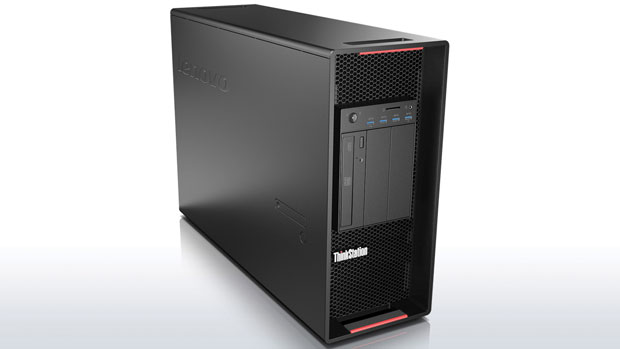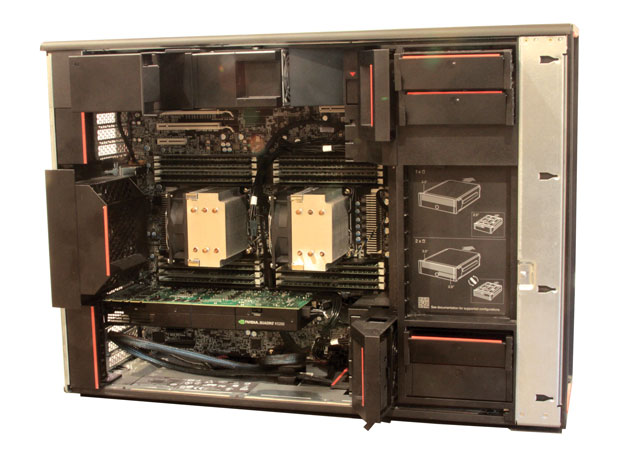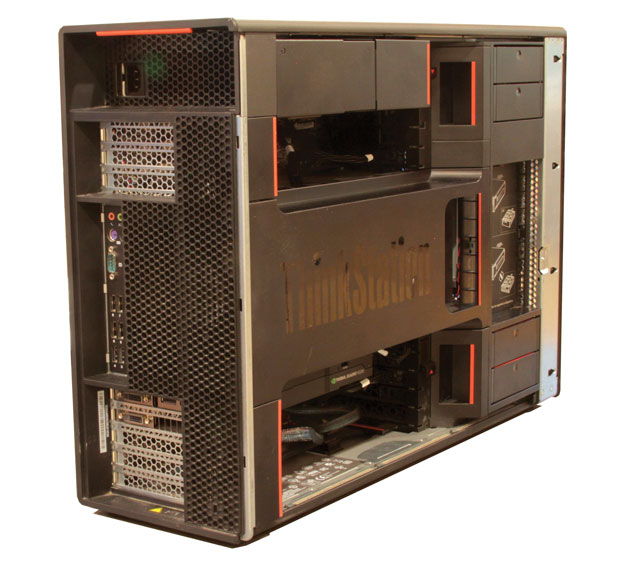Extreme Power and Performance

The Lenovo ThinkStation P900 has been redesigned from the ground up. Image courtesy of Lenovo.
August 3, 2015
Lenovo unveiled its redesigned ThinkStation P Series last August at SIGGRAPH 2014. We previously reviewed the P300 entry-level workstation but had to wait awhile before we could get our hands on the company’s new flagship workstation: the P900. To say that it was worth the wait would be an enormous understatement.
The Lenovo P Series has been redesigned from the ground up with the new ThinkStation P900 packing a tremendous amount of power in a large tower case that measures 7.8 x 17.6 x 24.4 in. (W x H x D) and tips the scales at 52 lbs. Thankfully, the new case includes three large handles—top front, top rear and bottom front—making it very easy to move around. Each handle is marked with a red touch point, a feature that becomes even more prominent once you open the case.The front panel has a new FLEX module that gives users the option to only add the components they need, allowing customized configurations that can incorporate ultra-slim optical drives, 29-in-1 media card readers and iEEE 1394 FireWire and eSATA ports. In our evaluation unit, the FLEX module contained the power button, a 9-in-1 media card reader, a headphone jack and four USB 3.0 ports, including one always on and capable of charging USB devices. Below this are three vertical 5.25-in. drive bays, one of which contained a standard 5.25-in. DVD+/-RW dual-layer optical drive. An optional Blu-ray drive is also available. The rest of the front panel surrounding the FLEX module consists of a perforated metal screen with the ThinkStation logo.
The rear panel provides PS/2 keyboard and mouse ports, a 9-pin serial port, four more USB 3.0 ports, four USB 2.0 ports, two RJ45 network jacks and audio jacks for line-in, line-out, and microphone. The NVIDIA GPU (graphics processing unit) in our evaluation unit added its own pair of DVI ports and two DisplayPorts.
Totally Tool-less
Accessing the interior of the P900 could not be easier. A lever releases the left side panel, which then slides off to reveal an interior reminiscent of the HP Z Series workstations. Red touch points give a clear indication of where users can grasp components that require no tools to remove. In fact, we found that the only components inside the ThinkStation P900 that would require a screwdriver to remove were the CPU heat sinks. Even the motherboard itself can be removed without tools by pressing its unlock button. This makes customization easy.
For example, the ThinkStation P900 offers a 1300 watt power supply with a built-in self-test. The power supply can be swapped out in seconds by simply pulling on its red touch point. On the motherboard, just below the power supply, are the first of the 8 PCIe expansion slots: a pair of x16 Gen3 slots as well as an x4 Gen 2 slot. Cards inserted in these slots are held in place by a rear panel bracket with its own red touch point. In front of these slots is one of several cooling fans, which can also be removed without any tools.
Along the front portion of the case are four drive bays, separated by the FLEX module, and identified by red touch points. Each bay contains a cleverly designed tray with blind connectors that can accommodate a 3.5- or 2.5-in. drive, or a pair of 2.5-in. drives. Lenovo offers lots of drive options, including standard 7200 rpm drives ranging from the 500GB drive in the base configuration to a 4TB drive, as well as hybrid and SSD (solid-state drive) options. You can also order systems configured with multiple drives in RAID 0, 10, 1 and 5 arrays. Our evaluation unit came with a single 512GB SSD installed in the lower-most bay, adding yet another $432 to the total system cost. PCIe SSDs are also available, for a total of 14 drive options.
 An air baffle conceals the CPU and memory sockets and ensures that fresh air reaches crucial components. Image courtesy of David Cohn.
An air baffle conceals the CPU and memory sockets and ensures that fresh air reaches crucial components. Image courtesy of David Cohn.A large direct cooling air baffle occupies the center of the case. This baffle conceals the two CPUs and 16 memory sockets and ensures that these crucial components receive ample fresh air. The baffle is actually divided into three separate channels so that each CPU and the memory sockets receive their own direct flow of air. This baffle is also easily removed by pulling on its red touch point, as is the dedicated 4.5-in. cooling fan.
Although the base configuration comes with a single Intel Xeon E5-2609 v3 processor, the P900 is a dual-socket system and Lenovo offers 42 different CPU configurations. Our evaluation unit came with a pair of 3.1GHz Intel Xeon E5-2687W v3 processors, each with 10 CPU cores. This Haswell processor has a maximum turbo speed of 3.5GHz, 25MB of SmartCache and a 160-watt thermal design power (TDP) rating. The pair added $7,150 to the cost of our evaluation unit.
The P900 base configuration comes with 8GB of RAM, installed as a pair of 4GB modules. But this ThinkStation can accommodate up to 512GB of memory using 32GB DIMMs (dual in-line memory modules). Our system came with 128GB, installed using 16 8GB DDR4 ECC 2133MHz RDIMM modules, adding $5,625 to the total cost.
Below the CPUs is a second pair of PCIe x16 Gen 3 slots along with another PCIe x4 Gen 2 slot and a pair of PCIe x1 slots. The basic P900 comes with an NVIDIA Quadro K620 GPU. Again, Lenovo offers lots of choices, ranging from an NVIDIA NVS315 board up to a pair of NVIDIA Quadro K6000s. Our evaluation unit came with an NVIDIA Quadro K5200 graphics board installed in one of the x16 slots. The K5200 has 8GB of dedicated memory and features 2304 CUDA parallel processing cores. This double-width board added another $2,034 to the system cost and blocked access to one of the adjacent x4 slots. Again, boards are held in place by another rear panel bracket with its own red touch point and cooled by yet another easily removable cooling fan.
Other options include NVIDIA Tesla and Intel Xeon Phi coprocessors as well as a Thunderbolt I/O card, optional Ethernet server cards, an IEEE 1394 FireWire adapter, and Flex Bay storage options.
Amazing Performance
We have often commented on Lenovo’s ability to combine and configure quality components for optimum performance, but the results we obtained from our ThinkStation P900 were nothing short of amazing. On the SPECviewperf benchmark, the P900 scored at or near the top on every dataset, even when compared to systems equipped with more powerful GPUs and faster processors.
On the SPECapc SolidWorks benchmark, the P900 surpassed every other system we have ever tested except for the single-socket, over-clocked BOXX APEXX 2. And on the multi-threaded AutoCAD rendering test, no other system could compete against the equivalent of 40 CPU cores. The ThinkStation P900 completed our test rendering in just over 16 seconds, nearly twice as fast its nearest competition.
We also ran the new SPECwpc workstation performance benchmark, and here too the Lenovo ThinkStation P900 turned in some of the highest numbers we have ever recorded. Yet the P900 was nearly silent, even when under heavy compute loads.
 Lenovo’s modular design features red touch points, making it easy to remove and replace components. Image courtesy of David Cohn.
Lenovo’s modular design features red touch points, making it easy to remove and replace components. Image courtesy of David Cohn.Lenovo pre-loaded Windows 7 Professional 64-bit. Windows 8.1 Pro 64-bit is also available. Like other Lenovo workstations, the new ThinkStation P900 comes with a three-year on-site warranty. A 104-key USB keyboard and USB optical wheel mouse come standard. The system is ISV (independent software vendor) certified for applications from Adobe, Autodesk, Dassault, PTC, SolidWorks, Avid and Siemens.
Although Lenovo touts a P900 starting price of just $1,826, few are likely to buy a system with this much potential equipped with entry-level components. Even if you were not keeping a running tally as we listed the cost of each upgrade in our evaluation unit, you can already anticipate the bottom line. As configured, our Lenovo ThinkStation P900 priced out at a whopping $16,599, putting it among the top three most expensive systems we have ever tested, but still nearly $2,300 less than the Microway WhisperStation. And we could have easily run the cost up even higher by adding more storage capacity, memory, and GPUs because our P900 still had plenty of room—and power—to spare.
Clearly, the Lenovo ThinkStation P900 is not for everyone. It is aimed at high-end CAD, CAE, research, rendering, special effects and the oil and gas industries. But if you need an extremely powerful system with lots of room to grow, your search has ended. The Lenovo ThinkStation P900 is a performance leader.
More Info
Subscribe to our FREE magazine, FREE email newsletters or both!
About the Author
David Cohn is a consultant and technical writer based in Bellingham, WA, and has been benchmarking PCs since 1984. He is a Contributing Editor to Digital Engineering, the former senior content manager at 4D Technologies, and the author of more than a dozen books. Email at [email protected] or visit his website at www.dscohn.com.
Follow DE






